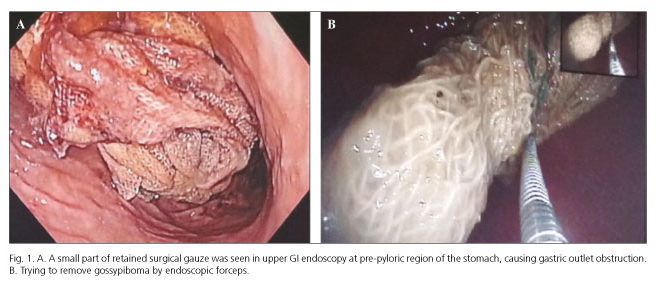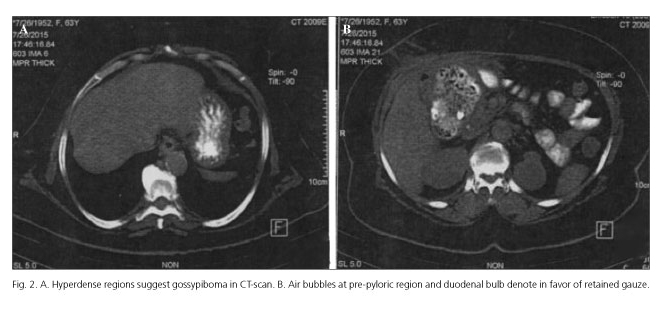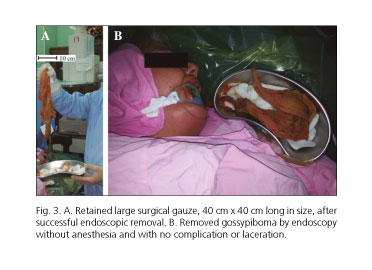Mi SciELO
Servicios Personalizados
Revista
Articulo
Indicadores
-
 Citado por SciELO
Citado por SciELO -
 Accesos
Accesos
Links relacionados
-
 Citado por Google
Citado por Google -
 Similares en
SciELO
Similares en
SciELO -
 Similares en Google
Similares en Google
Compartir
Revista Española de Enfermedades Digestivas
versión impresa ISSN 1130-0108
Rev. esp. enferm. dig. vol.109 no.1 Madrid ene. 2017
https://dx.doi.org/10.17235/reed.2016.4225/2016
Endoscopic removal of retained large surgical gauze: a case report
Manouchehr Khoshbaten1 and Sepideh Tahsini-Tekantapeh2
1Drug Applied Research Center. Tabriz University of Medical Science. Internal Medicine Department. Endoscopy Unit. EmamReza Hospital. Tabriz, Iran.
2Internal Medicine Department. Tabriz University of Medical Science. Liver and Gastrointestinal Diseases Research Center. Endoscopy Unit. Emamreza Hospital. Tabriz, Iran
ABSTRACT
In this paper, a 63-year-old woman was reported with recurrent abdominal pain after cholecystectomy. A retained surgical towel was seen by CT-scan in the peritoneal cavity, where it migrated across duodenum wall toward pre-pyloric region of the stomach. Endoscopic removal of the large retained gauze in size of 40 cm x 40 cm was successfully performed without laparotomy and with no complication. In the last years, the main method for removal of retained foreign objects has been open laparotomy or laparoscopy. We claimed that removal of large retained surgical long gauze is actually possible using upper GI endoscopy by expert endoscopists, and, therefore, there is no need for anesthesia or surgery as well as no occurrence of complication and laceration.
Key words: Gossypiboma. Retained foreign body. Retained surgical towel. Surgical long gauze. Textiloma.
Introduction
"Textiloma" or "gossypiboma" are terms used to express a rare iatrogenic mass due to remained non-radiopaque cotton sponge that has been forgotten after abdominal surgeries (1). The first case of a gastric gossypiboma was diagnosed by Erbay G endoscopically in 2012 (2). Gossypiboma is composed of a cotton material that approximately remains in 1/3,000 surgical processes, such as emergency surgeries, unexpected surgical procedures, poor organization, rapid sponge count, failure in sponge counting, prolonged operations, unstable patients and operations by assistants (1-4). Retained surgical towel may present as chronic abdominal pain, nausea and vomiting after feeding because of gastric outlet obstruction, when it migrates into the GI lumen (3,5,6). Diagnosis of retained surgical gauze is difficult in CT-scan without contrast, nevertheless it is possible to detect the spongiform structure, air bubbles, hyperdense regions, and spotted calcifications using contrast (1,7). During the last years, retained foreign bodies have been usually removed by open laparotomy.
Case report
A 63-year-old woman in whom an open cholecystectomy had been performed the previous year consulted our department. During 6 months, 20 kg significant weight loss occurred. During upper GI endoscopy, a white membrane was seen at pre-pyloric zone of the stomach. Removing it by endoscopic forceps was not possible initially and obstruction of pre-pyloric canal occurred (Fig. 1 A and B). It appeared that this retained gauze was too massive and long. A new endoscopy was performed one day after; we tried to remove it by endoscopic foreign body forceps, but after several hours, the retained surgical gauze entered the stomach gradually and it was impossible to pulling it out completely. A spongiform foreign body was seen in the peritoneal cavity by CT-scan, where it passed across the duodenal bulb wall, and then migrated to the prepyloric region of the stomach (Fig. 2 A and B). Due to the existing granulation tissue, it was impossible to suture as well as probable many post-operation complications such as fistula formation, the surgeons did not agree on removing gauze by laparotomy. Because of the need of emergency surgery, upper GI endoscopy was performed in the presence of the surgical team in operation room. At first, a cylinder-shaped part of gauze was removed and then its long tail was pulled out of the stomach (Fig. 3 A and B). Finally, removal of a 40 cm x 40 cm size long gauze by endoscopic forceps was accomplished successfully. After two days, the patient was discharged in well-being feeling and good feeding tolerance conditions, and with no abdominal pain. In follow-up endoscopy, complete healing of the duodenal wall was seen, without inflammation signs or fistulas after two month.
Discussion
Over the years, open surgery has been the mainstay method for retained surgical gauze removal. Up today, few cases have been reported in relation with removal of retained surgical gauze by upper GI endoscopy. The first case was performed by Sozutek et al. in 2013, where a 20 cm x 20 cm surgical sponge was removed while the patient was in anesthesia conditions in the operation room because of probable need for urgent surgery (8). In 2014, Henriques et al. removed endoscopically a gossypiboma migrated into the stomach leading to pre-pyloric obstruction (5). We report this case because of its large size and noninvasive removal by endoscopy without sedation or complication, and with no need of laparotomy. To our knowledge, we performed successfully and without complications the removal of intra-peritoneal retained 40 cm x 40 cm long surgical gauze by endoscopy, the major part of which was located at peritoneum and outside of duodenal wall.
References
1. Aydogan A, Akkucuk S, Yetim I, et al. Gossypiboma causing mechanical intestinal obstruction: A case report. Case Rep Surg 2012;2012:543203. DOI: 10.1155/2012/543203. [ Links ]
2. Erbay G, Koç Z, Calişkan K, et al. Imaging and clinical findings of a gossypiboma migrated into the stomach. Turk J Gastroenterol 2012;23:54-7. [ Links ]
3. Govarjin HM, Talebianfar M, Fattahi F, et al. Textiloma, migration of retained long gauze from abdominal cavity to intestine. J Res Med Sci 2010;15:54-7. [ Links ]
4. Henriques AC, Segre JM, Silva PA, et al. Endoscopic removal of foreign body abandoned in prior laparotomy. Arq Bras Cir Dig 2014;27:310-1. DOI: 10.1590/S0102-67202014000400023. [ Links ]
5. Kansakar R, Thapa P, Adhikari S. Intraluminal migration of gossypiboma without intestinal obstruction for fourteen years. JNMA J Nepal Med Assoc 2008;47:136-8. [ Links ]
6. Khan HS, Malik AA, Ali S, et al. Gossypiboma as a cause of intestinal obstruction. J Coll Physicians Surg Pak 2014;24(Suppl. 3):S188-9. [ Links ]
7. Kohli S, Singhal A, Tiwari B, et al. Gossypiboma, varied presentations: A report of two cases. J Clin Imaging Sci 2013;3:11. DOI: 10.4103/2156-7514.107998. [ Links ]
8. Ogundiran T, Ayandipo O, Adeniji-Sofoluwe A, et al. Gossypiboma: Complete transmural migration of retained surgical sponge causing small bowel obstruction. BMJ Case Rep 2011;2011.pii:bcr0420114073. DOI: 10.1136/bcr.04.2011.4073. [ Links ]
9. Sozutek A, Yormaz S, Kupeli H, et al. Transgastric migration of gossypiboma remedied with endoscopic removal: A case report. BMC Res Notes 2013;6:413. DOI: 10.1186/1756-0500-6-413. [ Links ]
10. Xu J, Wang H, Song ZW, et al. Foreign body retained in liver long after gauze packing. World J Gastroenterol 2013;19(21):3364-8. DOI: 10.3748/wjg.v19.i21.3364. [ Links ]
![]() Correspondence:
Correspondence:
Sepideh Tahsini Tekentapeh.
Tabriz University of Medical Science.
Internal Medicine Department.
Liver and Gastrointestinal Diseases Research Center.
Endoscopy Unit.
Emamreza Hospital.
51739-65673 Tabriz, Iran
e-mail: tahsinis@tbzmed.ac.ir
Received: 29-01-2016
Accepted: 12-02-2016
















